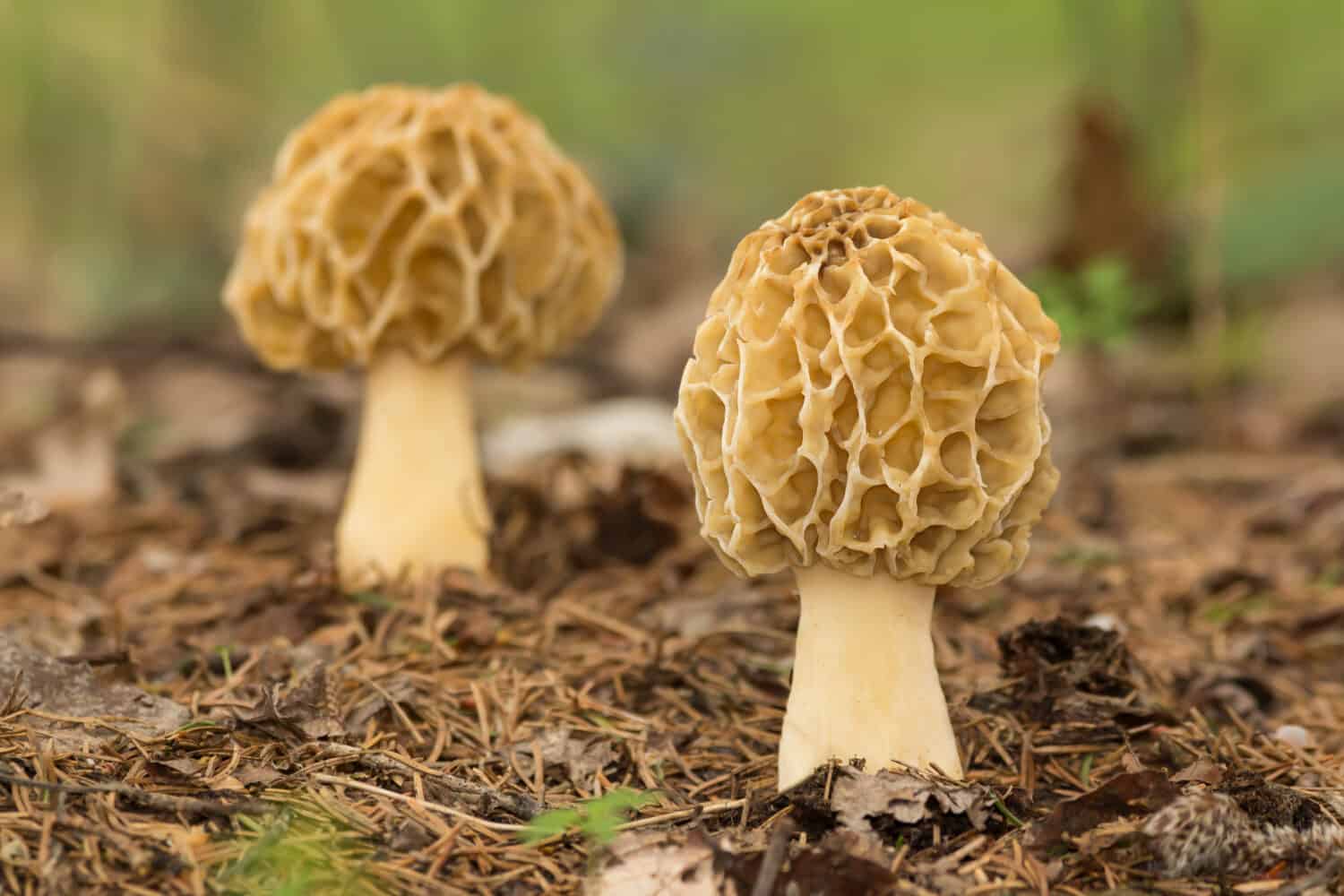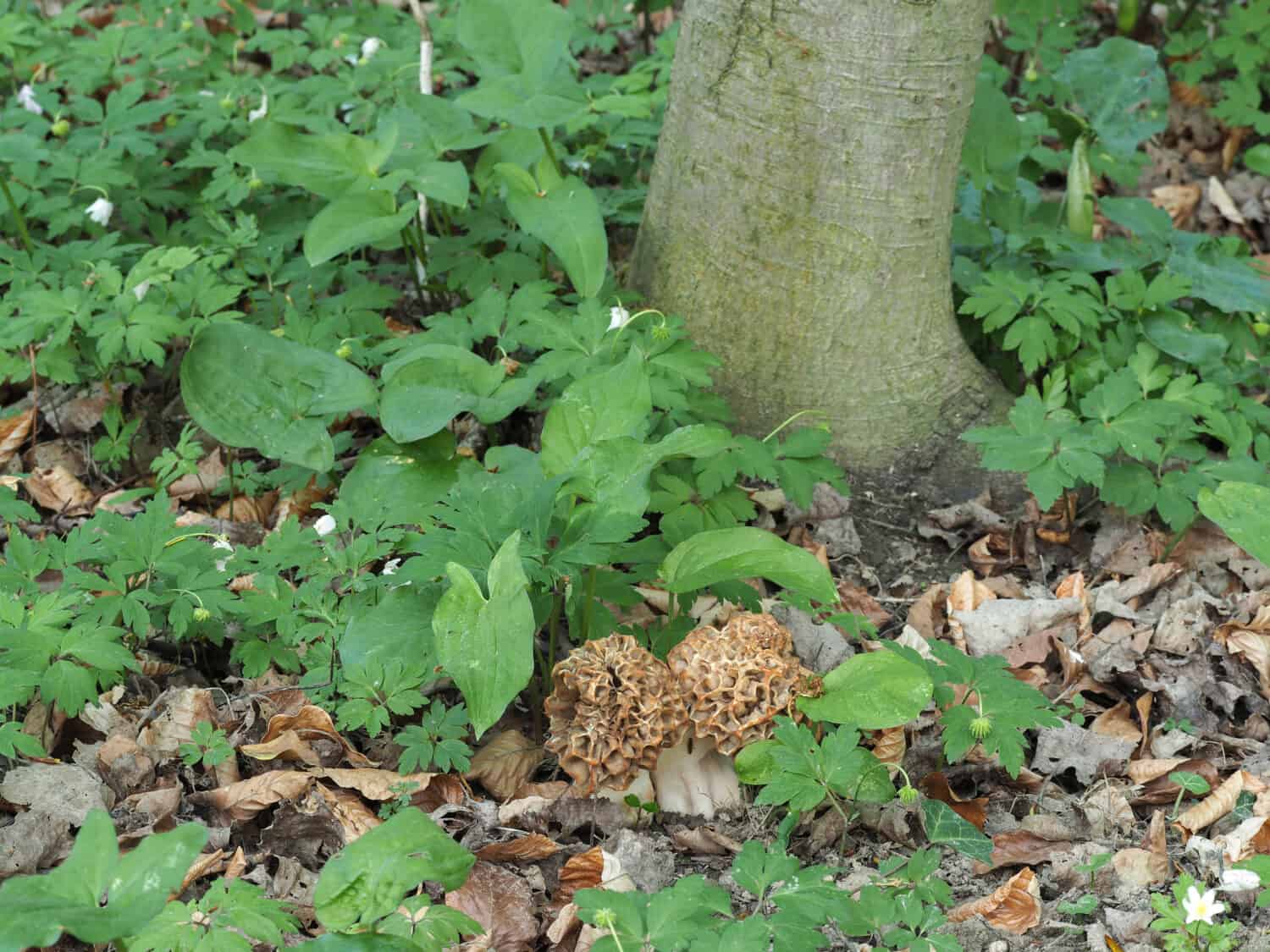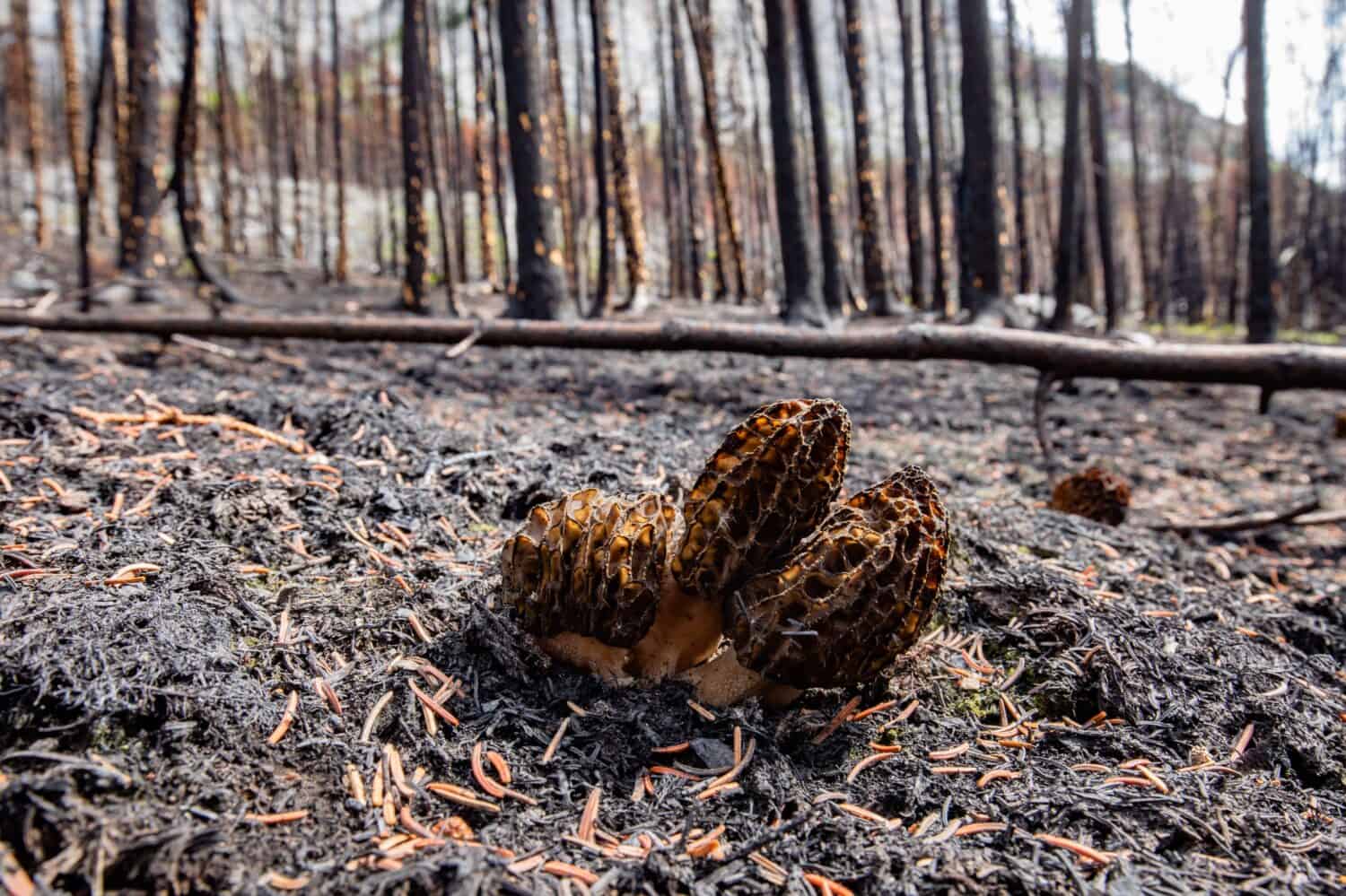Interested in knowing how to find morel mushrooms? Every spring, mushroom hunters take to the forests, trails, meadows, and even roadsides looking for these sought-after fungi.
In this guide, we’ll present an overview of mushroom foraging, cover what morels are and focus on a specific genus in Morchellaceae, and then provide tips for successfully foraging for these delicious fungi.
A General Overview of Mushroom Foraging

Mushroom hunting in the forest to find edibles to collect and carry home.
©Grusho Anna/Shutterstock.com
Before we dive into hunting for morels in particular, let’s zoom out first to talk about what we need to be safe(r), ecologically-minded, and informed mushroom hunters. Unless you are a well-practiced and studied forager, it’s best to go on forays with an established mushroom club or accompany a mushroom expert. This way, you can learn from knowledgeable folks in real-time and also stay much safer in your foraging.
The following list presents items we recommend bringing/wearing when foraging for mushrooms:
- A notepad and pencil (there’s so much data you can collect when mushroom hunting).
- Supportive footwear.
- A first aid kit if you’ll be trekking a ways into the woods.
- Water (gotta hydrate!).
- A mesh or woven bag or basket for collecting mushrooms (this helps keep the mushrooms fresh and allows spores to disperse as you walk).
- A sheathed fixed blade or foldable knife if you choose to cut rather than pluck mushrooms.
- A device to take photos.
Try to be mindful of where you’re walking to disturb the environment as little as possible. When harvesting, only take as much as you’ll reasonably eat or study, and try to always leave mushrooms from a flush for other folks and critters.
If you aren’t sure of the identity of a mushroom, while you certainly don’t want to eat a specimen you aren’t 100% sure is edible, you can still pluck it for studying! By taking photos, making notes and even taking a spore print, you may be able to get closer to knowing the identity of the species by sending your findings to reputable forums, a lab, or directly to a mushroom expert. Many mycological clubs host meet-ups where you can bring mushrooms for help in identification.
How to Find Morel Mushrooms: What Are Morel Mushrooms?

When you look closely, you can see why morels are part of the cup fungi.
©Luka Hercigonja/Shutterstock.com
Morel mushrooms are unique-looking fungi of the Ascomycota (or sac fungi) phylum. Many of the mushrooms folks hunt for belong to the Basidiomycota (the usual cap and stem mushrooms amongst others) phylum, but since morels contain spores internally in a microscopic sporangium called an ascus, they are considered ascomycetes.
To further categorize them, morels belong to the Morchellaceae family in the order Pezizales. These mushrooms are typically categorized by having conical, sponge-like caps characterized by a honeycombed pattern of ridges and pits. While there is some debate about the inclusion of other morels, such as Verpa bohemica, into the category of “true morels”, Morchella is typically considered the genus of true morels.
Other features that apply to the majority of true morels include a hollow interior and cap that is free from the stem (aka stipe). The half-free morel, Morchella semilibera is one notable exception.
What to Know about Morchella

Morel mushrooms cut open to reveal hollow inside.
©iStock.com/Helin Loik-Tomson
Before you head out on your mushroom hunt, it’s a good idea to become familiar with the native distribution, ecological niches, and growth cycle of true morels (currently limited to Morchella morels in this guide). Additionally, it’s extremely important to know that while these mushrooms are delicious and highly sought-after, they can make you quite sick and even cause neurological signs and symptoms if you don’t thoroughly cook them.
Within the Morchella genus, mycologists have identified three distinct evolutionary clades: the elata, esculenta, and rufobrunnea clades. Yellow morels roughly fit into the esculenta clade, black/grey, half-free, and burn-site morels generally correspond to the elata clade, and “blushing” or bruising morels (currently only two species) correspond to the rufobrunnea clade.
You can find these mushrooms widely distributed across North America, Central America, South America, Europe, and Asia. They may also appear less commonly across Africa, especially in South Africa.
Ecological Roles
The ecological roles of morels are a bit complicated and there’s not currently a clear answer on all of the ecological roles mushrooms in Morchella may fulfill.
Some species, such as M. rufobrunnea appear to be primarily or entirely saprobic. This means this species gains its nutrients from dead, decaying organic matter. You can often find M. rufobrunnea growing away from forests in wood chips, alongside roads, and along trails. This is also the successfully commercially cultivated species likely due to its more simple, primarily saprobic life cycle.
Other species, as in many within the esculenta and elata clades, may have more complex life cycles and might gain nutrients through saprobic, mycorrhizal, and even parasitic relationships. A mycorrhizal relationship is one in which both the host plant and the fungus benefit from a nutrient exchange. Current research suggests that some species in Morchella can form mycorrhizal-like structures as well as true ectomycorrhizal structures such as a Hartig net formation. Continued research is necessary to form more supported claims.
How to Find Morel Mushrooms: Tree Associations?

A morel growing next to it’s host tree.
©AleksandarMilutinovic/Shutterstock.com
While it’s not widely accepted or confirmed that morels in Morchella form mycorrhizal relationships, it is widely accepted that they appear to form some kind of association with certain tree species. Morels don’t fruit directly from logs or standing trees, instead, they tend to either appear scattered across the forest floor or growing from decaying matter such as wood chips in the case of M. rufobrunnea.
For the morels that appear to form associations with certain tree species, folks find them growing near both thriving and dead or dying trees, which may indicate that their ecological roles are varied and complex. Below we’ll cover the most common tree species that morels in the elata and esculenta clades tend to associate with.
How to Find Morel Mushrooms: Esculenta Clade Tree Associations

Morchella esculenta clade growing next to a tree.
©weinkoetz/Shutterstock.com
In North America, mycologists have currently confirmed five native species in the esculenta clade. One of the most common and widespread morels in this clade is Morchella americana (aka the common or blonde morel). Morels in this clade are typically referred to as yellow morels and you can usually find them growing under or near a number of hardwood species. The list of trees that morels in the esculenta clade tend to associate with include the following:
- Cottonwood
- Pear
- Apple
- American elm
- Tulip poplar
- White and green ash
So, if you know there are forests in your region populated by these trees, your best bet is to head out to these areas in search of esculenta clade morels between late March-early June.
How to Find Morel Mushrooms: Elata Clade Tree Associations

Morchella elate clade growing after a forest fire.
©Pi-Lens/Shutterstock.com
Currently, mycologists have identified 14 species of North American morels in the elata clade. Remember, this clade contains black/grey morels, half-free, and burn-site (or fire) morels. Some species in this clade appear to mostly grow near hardwood trees, such as Morchella angusticeps.
The exception is burn-site morels, which often appear in conifer forests, especially on the West Coast, after a fire. The flushes of burn-site morels that appear after a forest fire can be quite substantial.
So, the hardwood species that non-burn morels tend to associate with include:
- Tulip poplar
- Cherry
- American elm
- White and green ash
- Aspen
The conifer trees that burn-site morels tend to associate with include:
- spruce
- fir
- pine
When to Look and Other Tips

A beautiful harvest of fresh morels, right from the edge of the forest.
©Valmedia/Shutterstock.com
In North America, all species of morels in the Morchella genus appear in the spring. Foraging a couple of days after a rainstorm will increase your chances of finding a flush.
To spot morels that tend to appear in forests, look for pattern breaks along the forest floor. They can be a bit tricky to see, but once you notice how their unique caps tend to stand out against the broader scenery you’ll have an easier time processing finding them. Of course, you’ll have the best luck by learning to readily identify the trees they tend to grow under or near.
For morels that don’t seem to form associations with trees, like M. rufobrunnea, you may have luck finding them along trails, in gardens mulched with wood chips, and even along roadsides. They often appear in these kinds of disturbed areas.
The photo featured at the top of this post is © Ramazan Kurdanov/Shutterstock.com
The information presented on or through the Website is made available solely for general informational purposes. We do not warrant the accuracy, completeness, or usefulness of this information. Any reliance you place on such information is strictly at your own risk. We disclaim all liability and responsibility arising from any reliance placed on such materials by you or any other visitor to the Website, or by anyone who may be informed of any of its contents. None of the statements or claims on the Website should be taken as medical advice, health advice, or as confirmation that a plant, fungus, or other item is safe for consumption or will provide any health benefits. Anyone considering the health benefits of particular plant, fungus, or other item should first consult with a doctor or other medical professional. The statements made within this Website have not been evaluated by the Food and Drug Administration. These statements are not intended to diagnose, treat, cure or prevent any disease.
Thank you for reading! Have some feedback for us? Contact the AZ Animals editorial team.






